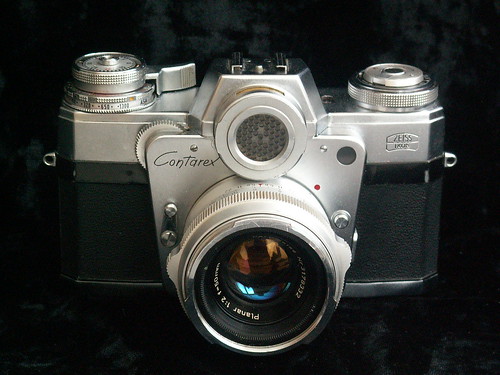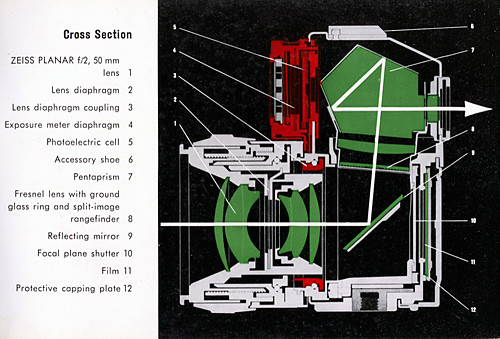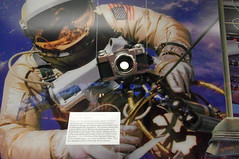Contarex I

|
| image by Howard Somerville (Image rights) |
The first Contarex, also known as the Contarex Bullseye and the Cyclops, is a 35mm SLR camera first shown as a working model at the Photokina in 1958[1]. It was the first SLR with a focal plane shutter made by Zeiss Ikon (West). Later variations include the Contarex Special (1960), Contarex Professional (1966), Contarex Super (1967) and Contarex Super Electronic (1968). NASA chose the Contarex to be the camera used in the first stages of spaceflight (Gemini program), famously Ed White used a modified Contarex in the first spacewalk during the Gemini IV mission (June 3rd 1965), the camera is on display at Wright Patterson Base
Contents
Development and production
The Contarex was intended as Zeiss Ikon's contribution to the professional photographer, replacing the Contax IIa and IIIa[2] and catering to any photographic task whatsoever. Preparations for the lens system began in 1954, when the internal name for the camera still was "Contax IV"[3]. The camera was designed by Edgar Sauer[4]. It is extremely heavy, and some consider the design to be "overloaded, angular and baroque" compared to camera development at Voigtländer at the time.[5]. However, to save the home grown Contarex and Contaflex, the development of a more modern styled Voigtländer TTL SLR camera was canceled by Zeiss Ikon head Dr. Heinz Küppenbender, after taking control of Voigtländer in 1956.[6]. The American journalist Bob Schwalberg expressed ironically about the size that "This is the smallest SLR camera in the 6x6 format I have ever seen"[7]. It weighs almost net 1.2kg, and is so complicated that it requires a skilled person even for the simplest repair. Even the removal of the top cover is a major task involving removal of several complex assemblies. The mechanism involved in film rewinding has two gear trains and three axles so as to avoid the internal meter movement. Still, gear damage is likely due to insufficient axle support. The camera consists of more that 1200 separate parts, and required almost 4000 different operations to assemble [8]. A special quality control system was developed by Zeiss Ikon for the Contarex, delaying the introduction of the camera, but ensuring that faulty copies were "practically impossible" [9]. Extra care went into the lens mounts, with the helical barrel ground by hand, something which would be "inconceivable and prohibitively expensive" today[10].

|
| image by Patrick Stacey (Image rights) |
From 1960 to 1967 Zeiss Ikon sold 32 000 Contarex I cameras, compared to e.g. 225 000 Leica M3s sold[11]. Partly this reflects the large price premium of the Contarex, even before considering the later Japanese competitors. For example in Germany around 1962-1963 the Contarex I was advertised at 1450 DM including the Zeiss Planar 50mm f/2, while the German competitors were both significantly lighter and cheaper, e.g. the Leica M3 with Summicron 50mm f/2 (1080 DM), Kodak Retina Reflex III with Schneider Xenon 50mm f/1.9 (730 DM) or Exakta Varex IIa with Exakta Pancolar 50mm f/2 (691 DM).[12]
While a technical masterpiece in many respects, the Contarex was a commercial failure, contributing to the collapse of one of the world's most storied manufacturers of cameras. By designing an overwhelmingly complex camera (though many features might be considered ahead of its time) and by adopting unusual form factors that differed dramatically from the products of every other manufacturer, the Contarex was the Edsel of cameras in many ways, significantly larger, heavier and more expensive than its German and Japanese competitors and quirky to the point of eccentricity. It is reported that Zeiss was so sure that the Contarex would be the most advanced, most comprehensive and most dependable 35mm SLR camera system ever built, that each screw of the camera, inside and out, was cemented in place, since repair would never be needed.
If it was only so.
Production serial numbers
The first Contarex series of 10 000 cameras was produced from 1959-1960, with serials from T 85001 to T 95000. Further runs were 5000 units from serial Y 6001 to 11000, 5000 units from Z 16001 to Z 21000 and another 5000 units from Z 46001 to Z 50404[13]. Later runs, with minor changes to the camera's features, include serials from D 20501 to D 21096 and D 21101 to 23604, produced from 1963-1964 and E 12001 to E 15000 and E 92001 to E 94500 from 1964 to 1965. The final run includes serials from G 30501 to G 33500, produced from 1965-1966. The total number manufactured based on these serials is 36004 from September 1959 until October 1966[14].
Contarex features
The first Contarex was generally available in 1959, the same year as Nikon and Canon also introduced their 35mm SLR cameras. However, the Contarex came with a built-in external exposure meter, and it was coupled to the aperture wheel by means of an aperture simulator, as well as to the shutter and film speed settings. In just a few years TTL full aperture metering was introduced by Topcon.
The camera body is clutter free and quite easy to use, once it is realised that the lens aperture is set using the aperture wheel to the right on the front and read off a scale on top of the camera in front of the accessory shoe. There is no aperture ring on the Contarex lenses. The shutter speed dial is at the hub of the wind-on lever. The wind lever is short, and the load increases noticeably for the last third of the 180° travel, from the point the mirror and lens iris joins the cocking operation. The shutter release at the top of it, is rough and difficult to press smoothly. It is surrounded by a frame-counter dial, which rotates forever. A serrated black index ring must be turned to the red mark on the dial when film is loaded, or to the frame number shown on the film magazine frame-counter if that is loaded. The rewind knob is at the left-hand camera top. The rewind release is engaged by turning the right-hand camera-back lock-key at the base. It is marked "R". The dial surrounding the rewind knob is a film reminder with three film-type indexes, one of these are set against tiny numbers on the edge of the rewind knob, assisted by a tiny stud at the dial. The large serrated outer knob is for easier camera grip. It does not rotate. On the front of the camera is on the left-hand side the sync. contact and the lens release button. On the right-hand side is a small self-timer lever. It is released by the shutter release.

|
| All settings can be read from the top of the camera image by Geoff Harrisson (Image rights) |
The selenium meter cell is in the Bullseye, at the front of the finder housing. It has a wide acceptance angle corresponding approximately to the standard lens. The meter movement is visible in an aperture to the right in the viewfinder, and also in a small window on top of the camera. All exposure parameters are coupled to the meter, even the lens aperture. This is accomplished using an aperture simulator. It is an iris replicating the lens aperture setting, placed in front of the selenium meter cell, and operated by the aperture wheel. To set correct exposure, an appropriate shutter speed is selected, and the aperture wheel turned until the meter needle is centered at the meter index mark. If no needle is visible, a different shutter speed might help, or possibly too little light is available. The meter baffle could be removed for incident readings in low light, giving a four-stop increase in sensitivity.
The shutter speed dial has speeds engraved in thin numbers from 1 through 1000 and a green B on the rim of the serrated chrome dial. The speed is set against a protruding black triangle on the edge of the wind lever. Flash synchronisation is automatic, provided the correct speed is set. The speeds on the shutter speed dial is colour coded for correct synchronisation:
- Black 1 - 1/30 sec. and B for fast M-bulbs.
- Yellow 1/60 sec. for electronic flash.
- Red 1/125 - 1/1000 sec. for slow FP bulbs.
The dial is difficult to read if no bright surface is reflected in it to contrast the numbers, and the colour coding is hardly visible for anyone not having acute vision.
The film speed dial is below the shutter speed dial. To set the film speed, the shutter speed dial is lifted and the thin serrated ring under it rotated until the correct number appears opposite a black triangle at the edge next to the number "2" on the shutter speed dial. Note that setting the film-speed to anything else than the green mark at the beginning of the ASA scale will limit the range of speeds available. In consequence, shutter speeds between 1/1000 and 1/15 sec. is available for the 100ASA setting. In low light, a second meter range is available by removing the light-baffle in front of the meter and using the Yellow index mark instead of the black triangle, in which case 1/1000 to 1 sec. is available for a 100ASA film.

|
| Diagram from the 1960 instruction book scanned by Geoff Harrisson (Image rights) |
The finder is extremely bright and clear with a split image rangefinder in the centre, surrounded by a very fine micro prism collar. The rest of the area has fine Fresnel rings. To the right is the meter index window, but the pointer is only visible when settings are very close to correct exposure. There is no way to tell where the pointer is without trying other settings. When the camera is wound, the lens is wide open, while after exposure it is closed to the preset aperture. Here is a quite remarkable thing: Even when the lens is closed down to F22, the screen is just as bright as many contemporary low cost SLR camera finders at full aperture. There is no way to believe this but to see it. It is a technological tour d'force.
The standard lens is the Carl Zeiss Planar 1:2 f=50mm in bright aluminium finish with a chrome 49mm thread filter ring and an outer bayonet for ZI filters. The latter tends to be too loose, with the resulting possibility of filters being lost. The lens focuses to 30cm, which is closer than most other optics of the time. The focusing helical is remarkably smooth and precise. There is no aperture ring on the Contax lens itself. It is set on the camera aperture wheel.
The basic Contarex System originally was the camera, a bellows unit and six lenses. The lenses were the 21mm f/4.5 Biogon, 35mm f/4 Distagon, 50mm f/2 Planar, 85mm f/2 Sonnar, 135mm f/4 Sonnar and 250mm f/4 Sonnar. The super-wide-angle Biogon had an impressive 90º angle of view. Its rear section extended into the camera body so it had to be mounted with the mirror locked up. An accessory viewfinder was needed, it was mounted in the accessory shoe.
The removable back is replaceable with an accessory film magazine back with dark slide, enabling mid-film change. The camera back is released by turning the two keys at each side at the bottom and pulled off downwards. Each magazine has its own frame counter. Using the magazine requires the proper procedure and it is best explained reading the user manual.
Second version
The first version Bullseye was Zeiss No.10.2400; the next version, Model D (No.10.2400D) was released in 1964 with a few minor changes. The meter baffle was altered to make it more secure and was now unlocked by a small release tab. The ASA range had been extended to 5 to 1600. Interchangeable focussing screens were an added feature. Also in the area near the viewfinder eyepiece there was now a 6mm slot that enabled a plastic data strip to be inserted and the written data recorded on the film. As the Contarex system was also aimed at the technical and scientific user this was another unique sales feature, along with the interchangeable film magazines. Another lens was added to the range at this time, a 50mm f/2.8 Tessar; it is almost identical in size to the 35mm Distagon.
|
|
|
Links
- Bullseye Contarex manual (PDF) from Mike Butkus's OrphanCameras.com
- Contarex on basepath.com
- Contarex used by NASA in Gemini missions on the Smithsonian Institution exhibits
Notes
- ↑ Journal of the Zeiss Historica Society, Volume 8, Number 1, Spring 1986, p. 14
- ↑ The Journal of the Zeiss Historica Society, Volume 14, Number 2, Autumn 1993, p. 6
- ↑ Journal of the Zeiss Historica Society, Volume 23, Number 1, Spring 2001, p. 4
- ↑ Journal of the Zeiss Historica Society, Volume 29, Number 1, Spring 2007, p. 6
- ↑ Westdeutsche Kleinbildcameras - wie sie gegen die Japaner verloren at Klassik-cameras.de
- ↑ Journal of the Zeiss Historica Society, Volume 15, Number 2, Autumn 1993, p. 6
- ↑ The Journal of the Zeiss Historica Society, Volume 14, Number 2, Autumn 1993, p. 4
- ↑ Journal of the Zeiss Historica Society, Volume 8, Number 1, Spring 1986, p. 12
- ↑ Journal of the Zeiss Historica Society, Volume 15, Number 2, Autumn 1993, p. 4
- ↑ Journal of the Zeiss Historica Society, Volume 15, Number 2, Autumn 1993, p. 4
- ↑ Ibid.
- ↑ (Photo-Porst) Der Photohelfer 62. auflage
- ↑ Journal of the Zeiss Historica Society, Volume 24, Number 1, Spring 2002, p. 15
- ↑ Journal of the Zeiss Historica Society, Volume 24, Number 1, Spring 2002, p. 16


